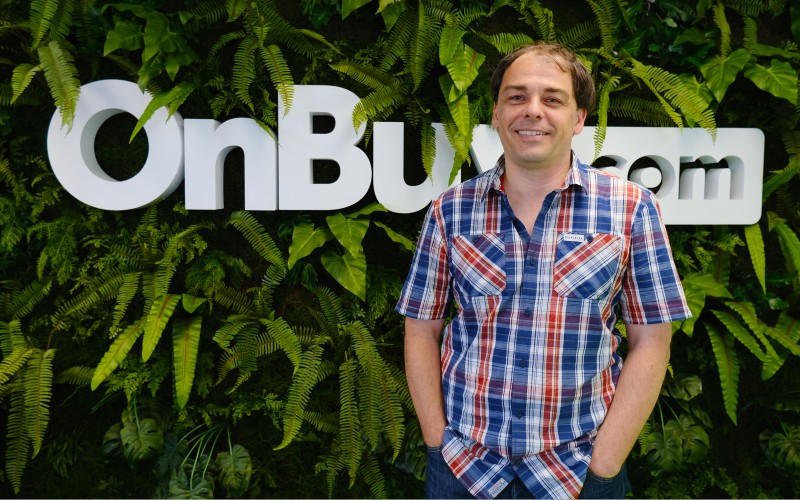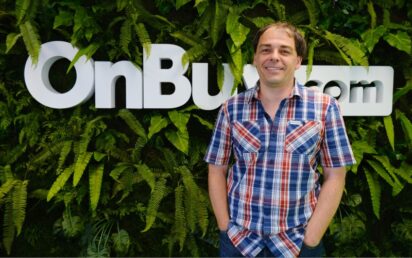eCommerce marketplace OnBuy is one of the UK’s most exciting technology businesses.
The Bournemouth-headquartered company, billed as an ethical alternative to Amazon, was voted No.1 on our RetailTech 50 innovation ranking this year while it was also listed on the FT1000 of the fastest-growing companies in Europe.
Led by founder and CEO Cas Paton, OnBuy has hired a number of stellar figures in executive roles in recent months. Among them is head of product Dan Seamans, who headed up the design, development and running of the early grocery home shopping apps for Tesco before spending almost four years leading software and digital product delivery at Domino’s Pizza in the UK & Ireland.
“I like a challenge,” he says of the decision to join OnBuy. “Unlike some of the companies I’ve worked at, where the most interesting stories are potentially told by long-serving staff members from the past, at OnBuy the chapters are there for us to write together.
“There’s some hygiene and basic stuff we’ll do – but actually there’s some far more interesting things than that which are there for us to go after.”
RetailTech 50 – UK’s most innovative retail technology creators for 2022
Fast growth
Founded in 2016, OnBuy’s ‘level playing field’ offering has attracted more than 11,000 retailers hosting more than 36 million products on the platform. In just four years, the company grew to £155m annualised GMV and with more than 100 staff members, moved its HQ from Poole to a stunning 12,000 sq ft space in the centre of Bournemouth.
Seamans says building a product team is crucial as the company scales. “I joined OnBuy at what I consider an early stage – so no product team at all,” he explains.
“The business was working fine without a product team, so my first challenge was to demonstrate why the product function should even be there, and show how it adds value… and the next challenge was what to do about the task list that already existed before there was a product function.”
On the speed of execution within the business, he adds to BusinessCloud: “We can build [a new functionality], deploy it to test users and get feedback from them within a day.”
Games development
Seamans has more than 20 years’ experience working in online, virtual worlds, games and app development, with more than ten years in management positions spanning the retail, education and entertainment sectors.
“I began my career in games testing, became a development lead, then went into product. But it all comes back to: how do you create interesting experiences? That thread has never changed,” he says. “I look at the core of what creates a sticky experience: something enjoyable, something rewarding.
“In games development – which is, I would say, a notoriously hard product space to develop in – the concept only ever really feels like it will work or not when you’re in the final 5% of development. That can be a lot of time and money spent before someone actually says ‘this is now fun’. For a long time, games are not fun when you’re building them, I assure you.
“In retail, we move into a territory where testing things early has become, rightly, a part of the norm, so you get the opportunity to see if the customer really warms, responds to and values what you’re building… you know what you’re chasing and it’s a bit easier to fulfil.”
Tesco & Domino’s Pizza
He continues: “Tesco was phenomenally interesting: FTSE 100, No.1 in the grocery sector, an absolutely huge juggernaut. How do you work at pace with something that big? And they were pacy: they had the ability to do some really good product calls, clearing the decks – if they really wanted to go after something, they knew how to go after it. That was invaluable to me and my career.
“Domino’s leads in its sector with a fabulous legacy of promoting itself and brilliant choices with its brand. People were still going through to food, but it was a completely different business model which then forms a completely different experience and technology.
“‘I’m ordering now because I want feeding now’ – that has to go through the thread of everything. It completely changes the business. It’s not ‘I’m ordering for next Saturday and I’ll build up a basket along the way’.
“Rather than allowing people to get in and out quickly to add one thing here and there, Domino’s is about giving them a great deal and seeing that experience through to the product being delivered through their door in, say, 30 minutes.
“That’s a very particular type of business. There’s not many businesses that are doing that. It’s very difficult, intense and high stakes: when an IT team talks about uptime or problems, most don’t have the problem that’s going to occur if Domino’s goes offline on a Friday night, during an England match or when the boxing’s on.”
Last year OnBuy closed £35m in Series A+ funding through VC and strategic technology investors, with the acquisition drive put into gear soon afterwards. Last week it announced the appointment of a new CTO.
“The customer experience is the No.1 priority for us,” says Seamans of the product team. “Being a marketplace, we can split customer: we can think about the seller as a customer, but also the more widely perceived version of customer, the person who’s paying the money for the product.
“Beyond that, it’s the concept of where or how can we create additional value to the business if it’s not immediately being driven by a customer need or a customer issue. What have we got on the table that are internal drivers for where we think we can add that value and it will be well received?”
Data science
Data science applies at all points of the development funnel, he says. “If we’re trying to solve a customer problem, that might have been directly born out of the data itself.
“If not, then the data team [will be consulted] at stage two on basically everything: what can you tell us? What are they doing here? What aren’t they doing? Can we even tell? There might be gaps that we need to fill in our understanding.
“We’ve got some really skilled and talented individuals in that team and in some cases, they continue with us through the entire product journey to help us test complex functionality. And then the most obvious way we lean heavily on the data team is at the end of things, when something has been put live and they can help tell us whether the outcomes were achieved.”


